Zone 10a-What’s in Bloom, What to Plant, What to Do
It’s January in our tropical garden. We live and dig in the Southwest tip of Florida. An essential fact about a tropical garden is that it is never finished! There is no seasonal end to our garden year. There is no “putting the garden to bed”. In our climate growing, blooming and cleaning up last all 12 months, The flowers are never gone in this zone, and the bugs never quit! The garden gate is always open!
Our Winter
January is our coldest month; our most delicate tropical plants are trimmed back and waiting for warmer days. But in this theatre we all call the horticultural world, there is always somebody ready to step into a starring role. A tropical garden has no shortage of prima donnas!
Bougainvillea blooms everywhere and it grows as as anything you want. It can be a vine, a shrub, a groundcover, or a tree-take your pick! It blooms all year but shines in the dry winter weather. There is more information to follow.
Our temperature, in January, should range between 74 and 56 degrees, which means the tourists are all swimming in the Gulf. We have had a few days so far in the ’80s, and that means the residents are swimming too!
You walk down the street, and you spot the tourists. They are in beach coverups dripping ice cream, and we’re in little fleece vests carrying hoes. We all stand out like petunias in the snow! (Or maybe like Americans in baseball hats and white socks in Paris!)
Life in Our Tropical Garden This Month
January for us is peak winter. From now on, this year, our weather will get warmer. Here is what is in bloom for us this month, what we plant and do. If you have or hope to have a little place in the sun for winter or all year, this is what you will be doing too!
A lot of you are doing just that, buying a little place in the sun. This month so far, the grocers can’t keep milk on the shelves, and the realtors have no inventory. The builders can’t keep up, and the wildlife is getting anxious. Our pretty little town is a hot market, and we have mixed feelings.
Visiting Florida
If you visit Florida this winter, here is an opinion piece from “The Points Guy” about the best times to visit Florida. (The image at the top is our town’s famous pier.) Leading Americans used it around the turn of the 20th century as the only way to get here for winter hunting and fishing.
Florida Gardens To Visit
If you are a gardener and visiting Florida this season, here are 7 Florida Public gardens we love to spend time in. With varied locations and styles, you should find a place to spend a day.
Weather and Environment
If our tender plants can freeze, this is the most likely month. See this US Government Temperature Chart for the low probability of freezing weather. We are northern gardeners transplanted south. Volunteer Master Gardeners in our community, we recreate what we once did in early spring in colder gardens. Mulch well for winter and be ready to cover plants if needed.
But These Are Perfect Days for Garden Dreamers…
“I like the dreams of the future, better
than the history of the past.”
-Thomas Jefferson
What’s in Bloom, What to Plant, What to Do
All of our gardens, however historical, are today the places for dreaming and digging. Our cool Florida Januaries are a time to make the dreams work. So today in the garden, we weeded, dug, raked, and picked up the annoying, smelly fruit of our Queen Palms. It’s not hot or wet this month; there’s no excuse not to be in the garden.
We have cool season greens and herbs to eat,now. We are both harvesting and and growing, For example, today, I planted more parsley and sowed some seeds of Chervil, The Chervil, we’ll eat, before summer heat takes it away! Fresh parsley, is available to us all year, we planted more because it is a biennial and we start a new one every year.
I will give you, below, the essential monthly data. Click to go straight to the information pertinent to you.
Our plants are tropical, but if you garden in a temperate zone, many of them will add to your summer garden or grow for you indoors. Click on plants of interest for more information, including winter storage.
A Garden for Wildlife
Wildlife abound, invited or not. We wake up to deer prints all around the house, and our game camera shows their nocturnal activity. Our garden lies sandwiched between the beachy part of town and a state forest. The deer love the sweet hibiscus leaves but hate both the Gardenia and especially, the Cuban Oregano. No deterrent is perfect,,, but the Cuban Oregano is distasteful to deer and marsh rabbits. You can use it outdoors in summer and indoors for winter wherever you garden in the temperate zone. It makes a beautiful marinade too!
Birds in the Garden
Our pond edge garden attracts both songbirds and wading birds all year, and by January the population is vast. Most winter migrating birds arrive in our gardens by early December,,, and by January,,, we see the first northbound birds from winter grounds in Brazil. Winter is unique because we now have all of our birds, and yours too! Thanks for the loan. We’ll send them back, well-fed, in spring.
Life on the Edge of the Tropics
How tropical are we?

This concrete buoy marks the southernmost point in the continental US. We can take a fast Cat to visit it on the island of Key West Florida. It’s a short drive to the ferry,, and the trip over water is about 109 miles.
The tropics is the area between the Tropic of Cancer, at latitude 23.26, N. and the Tropic of Capricorn at latitude. 23.43. S.
Our garden is at latitude 26,17, N. which is why we call it the “life on the edge of the tropics.”
In Key West-Tip the Bartender!
Recently two thoughtless visitors to Key West visited Duval Street’s many bars and, inexplicably, attempted to damage this monument.
They were easily caught because they failed to tip the bartender! A useful lesson for all!
January-What’s in Bloom, What to Plant, What to Do
What’s in Bloom
Mid-winter in South Florida is vividly colored. The days are bright and so are the blossoms and tropical foliage.
Bougainvillea-Bougainvillea
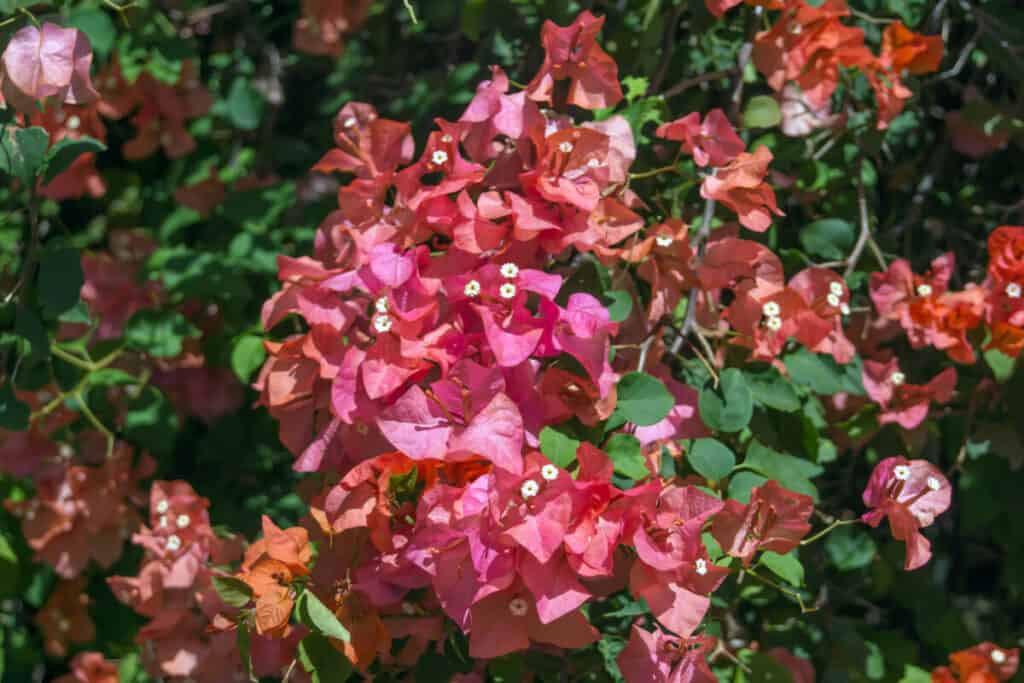
South Florida is famous for this tropical, twining shrub. It blooms its best for us from October through March and January is a perfect example. (It blooms in summer but is brightest without the heat and rain.) For us, it climbs walls, droops over fences, and grows as trees and shrubs. It has thorns (there are a few thornless varieties.) and we treat it with the respect it has earned. If you deal with roses, you know about thorns. We use the same heavy gauntlet gloves rosarians use. Here is how to select a pair.
Around here it’s nice to walk early in the morning before starting serious work in the garden and we see big splashes of bougainvillea’s exotic colors everywhere. How did we North Americans get this beautiful plant? It is native to a number of areas in South America. Discovered long ago it is named for Admiral Louis de Bougainville, the first Frenchman to circumnavigate the globe. Americans appreciate the fact that he fought on our side in the American Revolutionary War. A busy man.
Bougainvillea Facts
| Bougainvillea | Bougainvillea |
|---|---|
| Attributes | Colorful, tropical shrub in wide size range |
| Size | 1-35' check varieties |
| Soil | rich, loamy |
| Light | Full sun |
| Water | To establish |
| Nutrition | Balanced, slow release 5-5-5,10-10-10 |
| Zone | 9-11 |
| Diseases & pests | Relatively free |
Firespike Plant- Odontonema strictum
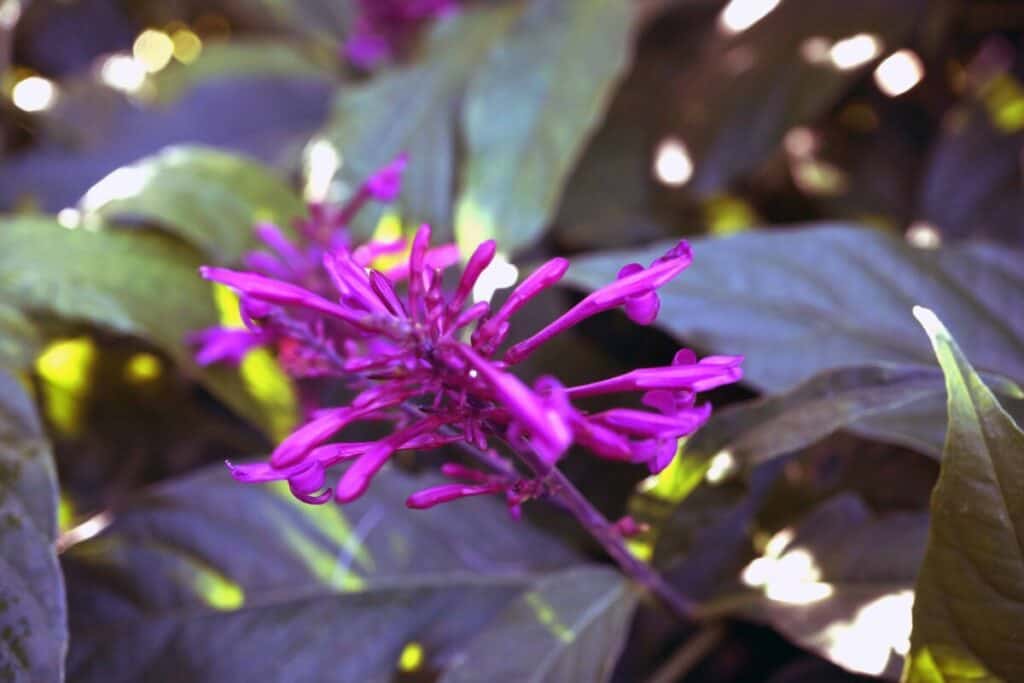
This is a big perennial shrub, reaching 4-8′ of dense foliage and long flower spikes. Loved by pollinators of all kinds it is most commonly found in red. We grow a big purple variety it looks more magenta to me, but why be pedantic? There is also a dark yellow version. You can grow this beautiful plant in your garden if you are in zone 8 or warmer.
Firespike is an upright, rounded plant with boldly veined shiny leaves that can reach 8″ long. The Flowers are on a long spike. It is a raceme except that the flowers are attached directly to the axis as opposed to a pedicel. It is in bloom during every month in which we have not pruned it back.
NB: a pedicel is a tiny stem, it comes from the Latin word for a little foot. The firespike flower is called sessile, there is no tiny stem, it sits right on the axis. Does that help?
The shrub has a wide growing range and it is a fast grower. Originating in Central America it is useful throughout Florida. Be prepared to prune several times each year. The plant entices many butterflies and may well be South Florida’s best hummingbird attractor. Plant this bush where you can see it throughout the day. Just sit down and watch the fun.
| NAME | Firespike |
| ATTRIBUTES | Tall, flowering, shrub |
| SIZE | 4-8′ |
| SOIL | Average |
| LIGHT | F/S-P/S |
| WATER | Regular |
| FERTILIZER | 3x year, slow-release, |
| ZONE | 10 |
| DISEASES & PESTS | Few |
Color Annuals
If you garden in northern zones, think of your favorite summer annuals and just reverse the year. Every one of those you love to plant in spring or summer, in beds, borders, or any kind of container thrives in our fall through spring period. This month pansies are in bloom, impatiens are in the full flush of color in both sun and shade. By May we will be pulling them out and replacing them with something like vinca for a similar look. But now they are easy to grow. Spires of salvia, both perennial and annual are more versatile. We keep annual salvia in bloom every day for several years before they need a change,
Foliage Plants
Many favorite foliage plants have tropical origins. They provide something of interest all day, every day, and all year. We all work hard to provide something of interest throughout the growing season. Succession blooming is harder than it looks, And, we quickly learn that nothing makes us gardeners look smarter at this than we are than beautiful foliage.
Researching foliage plants can be problematic. Try this exercise, just Google “foliage plants” and much of what you get will be “plants for fall color.” Here are some ideas you can use for all or part of the year and many will store well or will grow for you as indoor house plants in winter.
Some Plant Ideas for Colorful and Interesting Foliage

I made this image from actual Canna Lily foliage pictures. When the sun shines through there is a stained glass-like glow about the foliage. Plant them in the ground or in containers and store them for the winter.
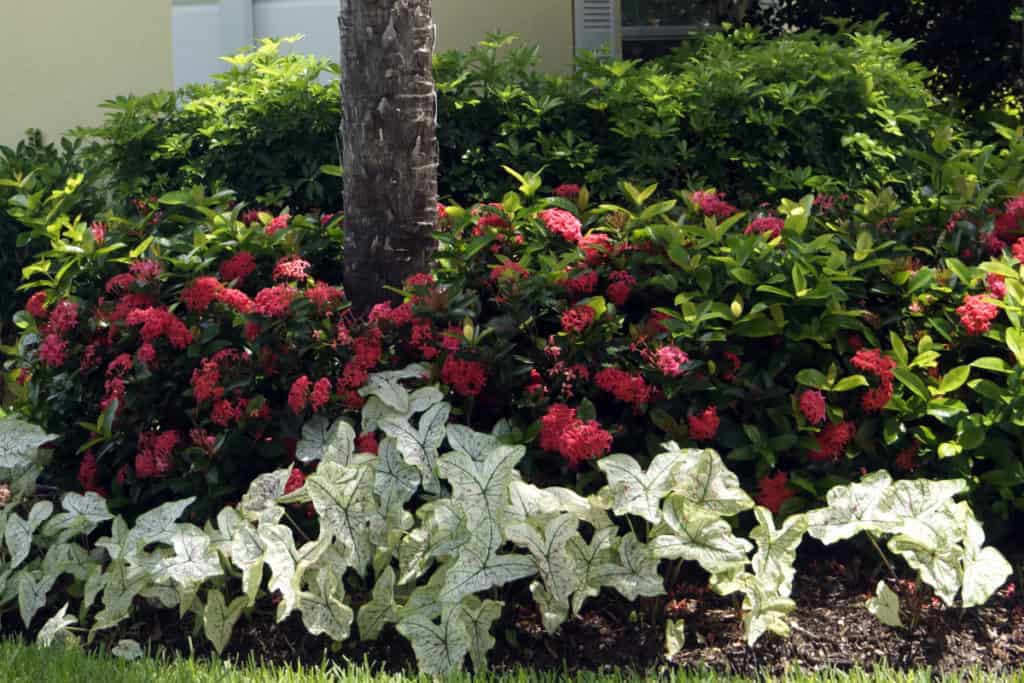
Caladiums are an exotic plant discovered by a North American plant hunter in the Amazon. Today 98% of the world’s supply is raised in small-town Florida. Visit pretty, Lake Placid where the crop is so important that they hold an annual festival. Buy the bulbs directly from the growers this winter, they will be shipped in time for your planting zone. Use in the ground this summer and in containers. Dig them up to save and reuse.
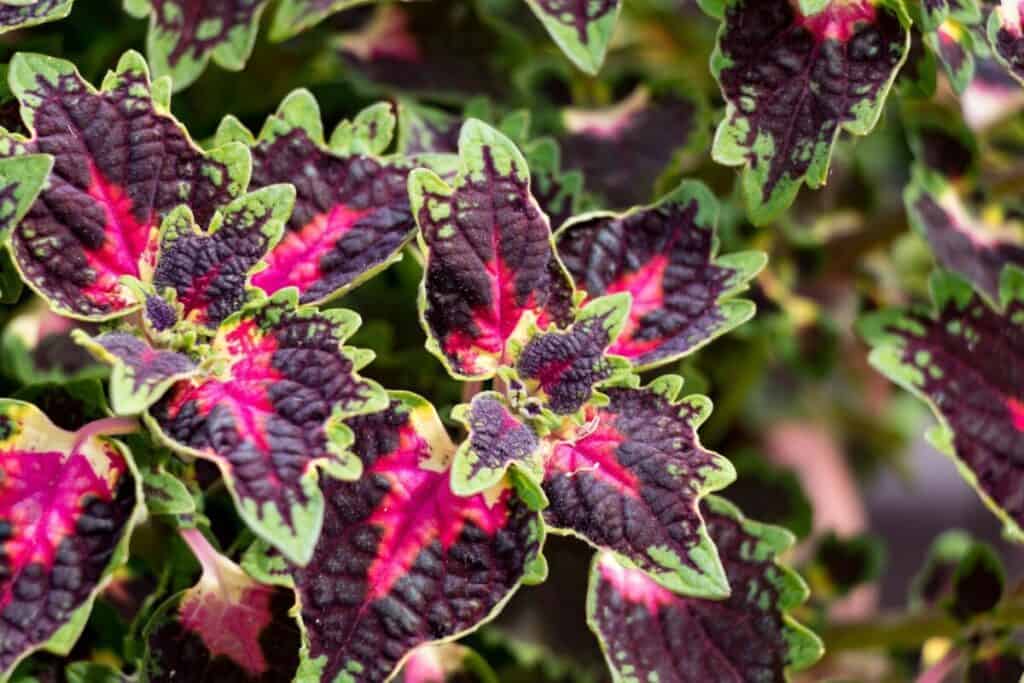
Coleus, today are bred in fascinating patterns and colors. Use as you would any annual and bring some indoors for the winter. If you look down on your garden from a high window you’ll think you left a Persian carpet outside.
What to Plant
| CATEGORY | EXAMPLES | REFERENCES |
| Bulbs | Agapanthus, Caladium, Clivia, Crinum Lily, | Bulbs for Florida |
| Color Annuals | Begonia, Dianthus, Dusty Miller, Impatiens Lobelia, Pentas, Salvia | Annuals for Florida |
| Herbs | Prime Herb Weather, plant for your kitchen | Herbs for Florida |
| Vegetables | Most vegetables, It is the last month to add Irish Potatoes | Vegetable Gardening in Florida |
What to Do
| CATEGORY | EXAMPLES | REFERENCES |
| Irrigation | This is the dry season. If the weather is dry and warmer than usual increase irrigation. | Landscape irrigation |
| Landscape Tasks | Start woody shrubs before summer rains. Download this complete plant guide for Florida or ask for a copy at your local county extension service. | Plant Selection Guide |
| Shrubs and Trees | Prune only non-spring flowering plants to improve shape this month, Trim trees for hurricane protection. | ISA Website |
The Garden, from Months to Days
What We Do Every Day
Mornings and evenings wandering the garden are something to treasure. Don’t miss them, I like to write about the seasons and how the garden brings us closer to nature’s changes throughout the year. Here, in our garden, the 4 seasons you may normally expect are replaced by two big ones. Cool and dry, hot and wet! The monthly changes are more subtle, but in the garden, it means we feature different plants.
Check, “what’s in bloom, what to plant, what to do” to get a look at the monthly progressions in this warm climate.
TODAY in the Tropical Garden
A gardener is always both the “big picture” person and the detail maven too. Never overlook the daily changes. A morning walk (with a coffee cup) is how to enjoy the garden, but it’s also how to stop the potential problems.
TODAY
I made this up to help remember what to do every day in the garden. It’s a little simplistic but it works.
T-Take a Walk
Take a walk-visit all the little outposts of the garden. Check edibles, blooms, walk the paths.
O-Observe everything
Observe- the layout, the state of growth, turn-over leaves. Check for dead or damaged branches. We carry little snips and correct problems while they are small. What did grandma say, ” a stitch in time…”
D-Look for Diseases and pests
Diseases and pests-turn the leaves, who is living underneath? Do you find discolored foliage? Remove any damaged plant part while it is small, Make a mental note to come back and spray, maybe a hard water spray will do!
A-Always check the water
Always check the water. Observe, if you can, when the water system is running, this is how to find the broken spots, buried heads. You can fix them before damage is done to the plants. A good example, in pots as a trailer we use a little white-flowered plant called Bacopa. Skip the water and dry it out once-it loses all the blossoms. Do it twice-it dies! It’s a great canary in the coal mine.
Y-Harvest the garden’s Yield
Yield- Harvest what you need. Carry sharp snips and cut the day’s kitchen herbs, vegetables, and flowers for the house.
When to do it. Morning is best, Take your coffee, (Florida produces juice oranges, we squeeze them in a little grinder. take a little glass outside.) You appreciate the garden before the day gets busy, you plan your day, (in the garden or beyond) and harvesting fruits, herbs, vegetables, or cuttings for the house, works best before the dew is gone.
Visit in the Evening, Too
The evening is fun too. Make a cocktail using your fresh herbs and fruit and take a walk. It’s a fine end to the day. (This link will take you to a herbed simple syrup you can make from plants you grow indoors or out.)
Tools We Use Every Day
There are tools we grab every day and take or wear into the garden. We wouldn’t be without them. There are some we want to hand, even on the morning or evening walks.
Garden Snips
These are small scissor like cutters and carried, always. Think of them as a cross between scissors and pruners (or secaturs). They are bypass cutters, operating like scissors, a sliding blade on each side. Carried for use on soft plants to deadhead, flowers and herbs to harvest for the house, they won’t crush the soft stems.
Features
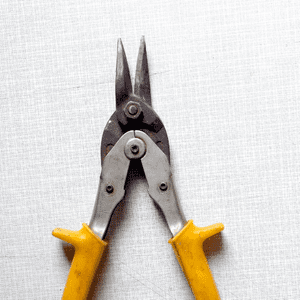
We like these as the first line in the toolbelt, because they are lightweight, sharp, small, convenient, and have safe closures. The small and pointy blades are perfect for cutting in tight spots and they will do less damage.
Summary
“The beginning is the most important part of the work”
-Plato
Life in the garden is always a continuum, and no garden makes that point clearer than the tropical garden. But we are entering a new year, 2022, and we can’t wait for the last one to be over. We have said good riddance to the prior two years, and we hope to give this one up a little more regretfully when next January arrives.
May this year be healthier, and more sociable. Next month, we will welcome new blooms, new food from the garden, and new chores. You may be starting new seeds under lights, we’ll be feeding plants and working on spring weeds before they emerge. We will prune shrubs that don’t bloom in spring and start our preparation for our inevitable hurricane season.
As much as we love the garden we hope to leave it behind and see someplace new this year. Come back in February and tell me how you like the new look.
